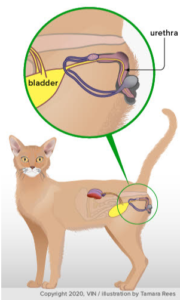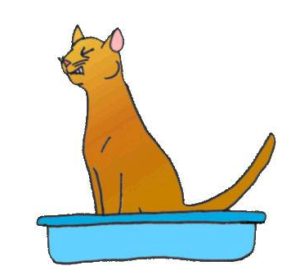Hello cat lovers – specifically, those that have at least one loveable furry male feline in their lives (or plan to get one in the future). This blog is especially for you! Male cats have a few additional considerations beyond general cat things. The things we are going to touch on today are neutering and urethral blockage. Note: urethral blockage results in not being able to pee and is an immediate medical emergency!
So, neutering. If you adopted a male cat from a shelter, odds are he is already neutered or has an appointment set up by the shelter. If you get a kitten that has not been neutered or adopt/take in an adult male cat, why would you want to put him through neutering? The main answer – is smelly, smelly urine that he will likely want to mark around your house. An unneutered male cat has very strong-smelling urine, and if he ever happens to urinate (full void, usually on a horizontal surface) outside of the litter box, the urine will leave a very strong odor where it is. The litter box itself will have a very strong smell, which has to be taken into consideration when deciding on a location, cleaning schedule, and how many other cats may be expected to use that box. Unneutered male cats also tend to be very territorial – more likely to start fights with housemates, and very prone to urine marking around their territory (your house), even if the perceived threat to their territory is outside. The overall results are generally very unpleasant.
An overall note on spaying and neutering cats – this is very important for population control as well. Intact female cats do their best to attract as many males as possible when in heat, so a nearby intact female could make your male cat more prone to trying to escape. Unneutered male cats are much more likely to want to roam and get into fights with other neighborhood cats while doing so. And while kittens are undeniably cute, you are not “taking the experience of fatherhood” away from a cat when you neutered him – male cats are typically not at all involved in nurturing kittens. There are so, so many cats and kittens that end up in shelters – please consider this option before deliberately planning a litter. As a side note, unspayed female cats are at high risk for mammary cancer (which is 90% malignant in cats), so deciding that you want “one litter before you spay her” could literally result in her developing cancer later in life.
Now, on to urethral blockage. Every small animal veterinary professional is very familiar with seeing “possibly blocked cat” show up on their emergency schedule. For basic anatomy – the urethra is the tube that takes urine from the bladder to the outside of the body. If this tube gets blocked – either with a stone, “grit” (crystals), or a mucous plug, it is very bad news. Even if a cat cannot urinate, the kidneys will continue making urine, so the bladder will fill more and more until it is basically a large, rock-hard ball in the abdomen. The bladder at this point is very painful and at risk of rupturing. Also, the backward pressure from the overly full bladder on the kidneys can very quickly (within 48 hours) put a cat into kidney failure, allowing toxins to build up in the bloodstream. If your cat cannot urinate, this is a medical emergency. It cannot wait until tomorrow.

Illustration: veterinarypartner.vin.com (Tamara Rees)
What are the signs that a cat is blocked?
Straining in the litter box – this can look like constipation, but it is very important that your cat be checked out to make sure that it can urinate. This is especially important for multi-cat homes where it may not be obvious if one cat has stopped urinating because there is other urine in the box.
Crying or howling – this can happen while straining, or separately.
Licking at the penis (located under the base of the tail)
Abdominal pain when picked up – this is from the painful bladder
Hiding
Vomiting, not eating
Recent episodes of blood in the urine or frequent urination of small amounts

Illustration: veterinarypartner.vin.com (Wendy Brooks, DVM)
Sometimes a cat can be unblocked by anesthetizing them and passing a urinary catheter – sometimes this is easy, and sometimes this is difficult. There are times when a catheter cannot be passed, in which case a perianal urethrostomy is performed – a larger surgery to remove the stone or blockage that also removes the “skinny” part of the urethra where stones, crystals, and mucus tend to get stuck. This will not prevent future urinary tract infections or cystitis but should prevent life-threatening urethral blockage from recurring.
So to repeat – NOT BEING ABLE TO URINATE IS A MEDICAL EMERGENCY. Please call us or your local emergency clinic immediately if you are concerned that your male cat cannot urinate. It is possible for male dogs and female cats and dogs to become obstructed as well (depending on the size of the stone, etc) but it is much rarer. In general, if you suspect any animal is completely unable to urinate, that animal needs to be evaluated immediately.
Further reading on urinary blockage and perianal urethrostomies:
https://veterinarypartner.vin.com/default.aspx?pid=19239&id=4951735
https://veterinarypartner.vin.com/default.aspx?pid=19239&id=6465677
Further reading on urinary issues in cats:
https://veterinarypartner.vin.com/default.aspx?pid=19239&id=4951487
https://veterinarypartner.vin.com/default.aspx?pid=19239&id=4951488
https://veterinarypartner.vin.com/default.aspx?pid=19239&id=4951508
In conclusion: male cats can be excellent companions – especially when neutered – just keep an eye on that litter box.
–Dr. Dana Muir
